Country and Marine Parks
WORK OF THE COUNTRY AND MARINE PARKS BRANCH
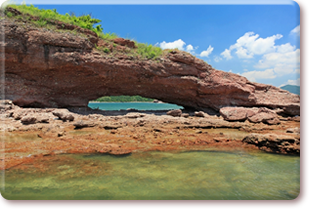
- To conserve the natural environment through the identification, designation and management of suitable areas as country parks, special areas, geopark, marine parks and marine reserves;
- To conserve important marine and terrestrial fauna and flora, such as the Chinese white dolphins, finless porpoises, coral communities, birds, mammals, butterflies and dragonflies;
- To promote nature appreciation through publicity and educational activities and the provision of suitable facilities.
COUNTRY AND MARINE PARKS
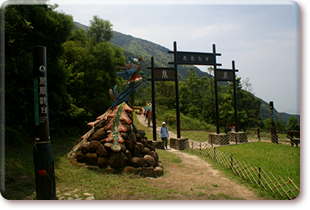
To conserve the countryside, by March 2013, 44,239 hectares (about 40 % of Hong Kong's total land area) have been designated as country parks and special areas. The Department manages all 24 country parks and 22 special areas for conservation, recreation, education and tourism. Hiking trails, mountain bike trails, nature trails, barbecue and picnic sites, camp sites and visitor centres are provided in the country parks, drawing some 12.69 million visitors in 2012-13.
The Department manages 4 marine parks and 1 marine reserve for conservation, recreation, education and scientific studies, covering 2,430 hectares. They comprise scenic coastal areas, seascapes and important marine habitats with an abundance of important marine fauna and flora, providing ideal opportunities for diving, snorkelling, canoeing and underwater photography. Some 192,640 visitors to marine parks were recorded in 2012-13.
A map showing the country parks, special areas, marine parks, marine reserve and the Hong Kong Global Geopark of China is at Appendix 13.
HILL FIRES
In 2012-13, 18 hill fires occurred over an area of 79 hectares with 6,400 trees damaged within or adjacent to country parks. There were a few major fires in Tai Lam Country Park, Ma On Shan Country Park and Shing Mun Country Park. Rehabilitation planting programme in areas damaged by hill fires and various fire prevention measures have been implemented.
TREE PLANTING
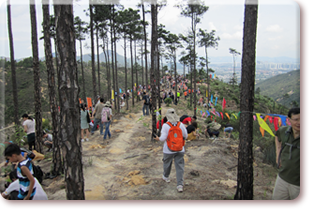
Some 720,000 seedlings were planted in country parks in 2012-13. To enrich local plant diversity, the Department continued to produce and plant seedlings of native tree species. Major native species planted included Castanopsis (Castanopsis fissa), Chinese Hackberry (Celtis sinensis), Gordonia (Gordonia axillaris), Sweet Gum (Liquidambar formosana), Zhejiang Machilus (Machilus chekiangensis), Many-nerved Machilus (Machilus pauhoi) and Chinese Gugertree (Schima superba). Among all seedlings planted, 80% were native species.
Seedlings are produced in Tai Tong Nursery for tree planting in country parks. Located in Tai Lam Country Park with an area of 9.5 hectares, the nursery produces over 650,000 seedlings of more than 100 species annually.
COUNTRY PARK PLANTATION ENRICHMENT SCHEME
In the early years, exotic pioneer species such as Taiwan Acacia (Acacia confusa), Brisbane Box (Lophostemon confertus) and Slash Pine (Pinus elliottii) were planted to prevent soil erosion and to quickly restore vegetation cover. This objective has been achieved with sustained efforts in the last few decades.
With time, existing plantations in country parks are facing problems such as aging, withering and overgrowing. Trees species found within the plantations are relatively uniform comprising mainly exotic species, making it difficult for them to fully satisfy the needs of native wildlife for food and shelters. In addition, the dense canopies of the trees could have affected the natural propagation of native trees. To enhance the landscape and ecological value of these existing plantations, the Department launched the Country Park Plantation Enrichment Scheme (the Scheme) in 2009 to enrich the overall value of country park plantations. The objectives of the Scheme are as follows:
- To improve the ecological habitat of the plantation areas;
- To increase the biodiversity of both local flora and fauna;
- To allow healthy growth and sustainable development of the woodlands;
- To provide seeds of native trees;
- To enhance the landscape of the country park plantation areas; and
- To reduce the chance of pest outbreaks.
During the dry season of 2012, 16 sites were engaged under the Scheme and about 2,800 exotic trees in poor conditions were removed. Suitable native tree seedlings were in-planted in the plantation areas in the following planting season of 2013. It is expected that the newly planted seedlings would gradually establish in the thinned woodland, and eventually replacing all the exotic species. The Department will continue to carry out the Scheme in the coming years to improve all plantations in country parks systematically to enhance the overall ecological value of the country parks.
In addition to enhancing the ecological value of country parks plantations, thematic plantings which would display seasonal colors were also planted in selected recreational facilities frequented by country parks users to promote the aesthetic value of woodlands in country parks. A case in point is the red leaves of Sweet Gum trees (Liquidamber formosana) planted near Tai Lam Nature Trail in Tai Tong. It has become a major attraction in autumn. The Department would continue to explore suitable locations for other thematic plantings.
TREE MANAGEMENT
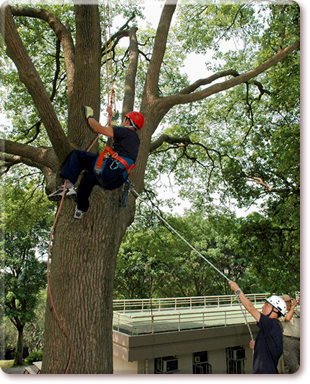 To improve tree management in Hong Kong for the sake of public safety, the Department has stepped up efforts on tree inspection, risk assessment and tree maintenance at the recreation sites of country parks and the areas adjacent to non-expressway public roads. Over 36,000 trees (involving about 1,200 sites and 620 tree groups adjacent to public roads) and 5 Old and Valuable Trees have been inspected. Tree management measures such as pruning and thinning, were prescribed for trees in poor health conditions or with high potential danger to the public. Tree management work was carried out by qualified and experienced in-house staff.
To improve tree management in Hong Kong for the sake of public safety, the Department has stepped up efforts on tree inspection, risk assessment and tree maintenance at the recreation sites of country parks and the areas adjacent to non-expressway public roads. Over 36,000 trees (involving about 1,200 sites and 620 tree groups adjacent to public roads) and 5 Old and Valuable Trees have been inspected. Tree management measures such as pruning and thinning, were prescribed for trees in poor health conditions or with high potential danger to the public. Tree management work was carried out by qualified and experienced in-house staff.
MOUNTAIN BIKE ACTIVITIES
 To cope with the increasing popularity of mountain biking activities in country parks, a new section of the Ho Pui Section Mountain Bike Trail in Tai Lam Country Park was built and opened to the public during the year.
To cope with the increasing popularity of mountain biking activities in country parks, a new section of the Ho Pui Section Mountain Bike Trail in Tai Lam Country Park was built and opened to the public during the year.
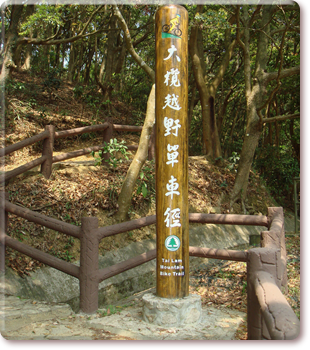
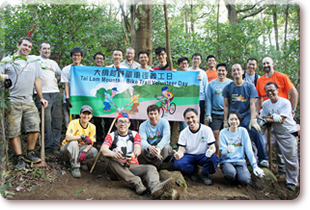 The new section is 1.4 km long and located near the entrance of Tai Lam Country Park at Tsuen Kam Au, Route Twisk. It connects with the existing Ho Pui Section Mountain Bike Trail, but is separated from the hiking trail so as to minimise the potential conflict between bikers and hikers. The new section is designed in accordance with the principles for sustainable trail promulgated by the International Mountain Bicycling Association of USA, and is suitable for cyclists with advanced mountain biking skills. A number of challenging features such as drop-offs and gravel-covered stretches are provided along the trail to make it more enjoyable for the advanced cyclists.
The new section is 1.4 km long and located near the entrance of Tai Lam Country Park at Tsuen Kam Au, Route Twisk. It connects with the existing Ho Pui Section Mountain Bike Trail, but is separated from the hiking trail so as to minimise the potential conflict between bikers and hikers. The new section is designed in accordance with the principles for sustainable trail promulgated by the International Mountain Bicycling Association of USA, and is suitable for cyclists with advanced mountain biking skills. A number of challenging features such as drop-offs and gravel-covered stretches are provided along the trail to make it more enjoyable for the advanced cyclists.
HONG KONG GLOBAL GEOPARK OF CHINA
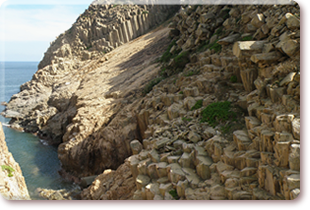
A geopark which is a unique natural area with special geological significance includes facets of natural and cultural heritage as well as serves the objectives of conservation, education and sustainable development. The purpose of Hong Kong Geopark, which opened in 2009 and acquired global status in 2011, is to protect Hong Kong’s rich geological resources and their high research, tourism, educational and scenic value.
To better promote Hong Kong Global Geopark to visitors, a Volcano Discovery Centre is planned for downtown Sai Kung, which is situated at the gateway to Hong Kong Geopark. The centre, expected to open in 2014, will serve as a convenient starting point for visitors, and tell the story of the volcanoes in ancient Hong Kong and how they have shaped the landscape over 100 million years ago.
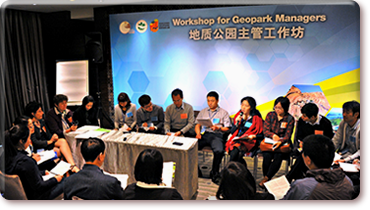
A Roundtable Conference, organised by Hong Kong Global Geopark in October 2012, provided an opportunity for representatives from some 20 geoparks and 5 academic institutes from mainland and overseas to share their latest initiatives and plans relating to geoconservation, geotourism and geoparks.
A Workshop for Geopark Managers was held from 25-28 March 2013. The workshop brought together geopark managers from 13 geoparks in the Mainland and Japan with the aim of enhancing geopark management and strengthening the geopark network. The geopark managers participated in a wide range of activities including seminars, discussions, e-classroom and visits to local geopark facilities. They also exchanged ideas and shared their experience on the management of geoparks.
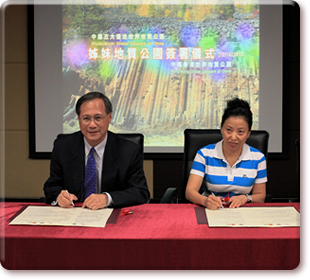 On global networking, sister arrangements were signed with Marble Arch Caves Geopark and Wudalianchi Geopark in May and October 2012 respectively, bringing the total number of Hong Kong's sister geoparks to seven. Efforts had been made to organise educational and promotional activities in collaboration with our sister geoparks.
On global networking, sister arrangements were signed with Marble Arch Caves Geopark and Wudalianchi Geopark in May and October 2012 respectively, bringing the total number of Hong Kong's sister geoparks to seven. Efforts had been made to organise educational and promotional activities in collaboration with our sister geoparks.
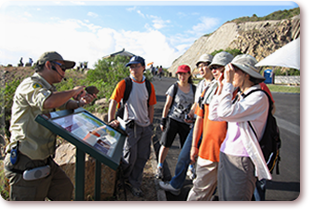 School education is a main focus of Hong Kong Geopark in promoting science popularisation. A Geopark School Programme has been set up to help participating teachers and their students to develop a long-lasting interest in earth science, to be integrated with ecology and cultural heritage, and to explore the links between science and art. These integrated activities have been effective in arousing students’ interest in geology and advancing their understanding of complicated geological concepts in an enjoyable way. In 2012-13, 10 schools participated in the pioneer scheme.
School education is a main focus of Hong Kong Geopark in promoting science popularisation. A Geopark School Programme has been set up to help participating teachers and their students to develop a long-lasting interest in earth science, to be integrated with ecology and cultural heritage, and to explore the links between science and art. These integrated activities have been effective in arousing students’ interest in geology and advancing their understanding of complicated geological concepts in an enjoyable way. In 2012-13, 10 schools participated in the pioneer scheme.
NATURE CONSERVATION EDUCATION
Nature Appreciation Activities
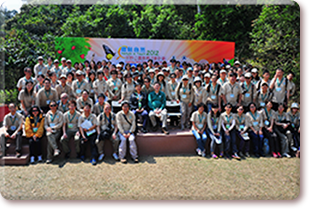
In 2012-13, the Department conducted a series of conservation activities for over 280,000 local students, teachers and nature lovers. The Department continued to carry out the Country Parks Education Programme "Nature in Touch" to strengthen the educational resources on nature conservation in country parks. This programme aimed at promoting a better understanding of country parks, biodiversity, flora conservation and geological characteristics in Hong Kong, thus enhancing public awareness of the importance in protecting the natural environment. The programme included a series of countryside learning activities for students and nature appreciation activities for the public.
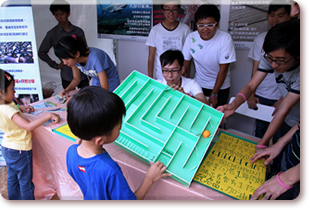 School education programme implemented this year included Country Parks Orienteering, Kindergarten and Primary School Visits, and school eco-tours. To encourage secondary students to gain insight of various conservation work in country parks, the "Country Parks Reporter Inter-school Competition" was held. The Department also organised outdoor field study activities to help teachers utilise the teaching tools in "Hong Kong Country Parks Education Kit for Secondary Schools" tailored for teachers.
School education programme implemented this year included Country Parks Orienteering, Kindergarten and Primary School Visits, and school eco-tours. To encourage secondary students to gain insight of various conservation work in country parks, the "Country Parks Reporter Inter-school Competition" was held. The Department also organised outdoor field study activities to help teachers utilise the teaching tools in "Hong Kong Country Parks Education Kit for Secondary Schools" tailored for teachers.
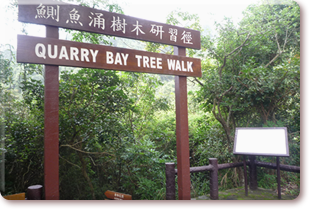 Public education programme comprised a wide variety of activities including guided tours at Nature Education Centres, Tree Walks fixed-point interpretation, "Nature in touch" workshops and themed exhibition and competitions to promote nature conservation. "Great Outdoors Hong Kong!" , "Hiking and Planting Day" and "CAS Hiking Safety Promotion Day" activities were held to introduce to the public the fun of hiking and the associated safety knowledge.
Public education programme comprised a wide variety of activities including guided tours at Nature Education Centres, Tree Walks fixed-point interpretation, "Nature in touch" workshops and themed exhibition and competitions to promote nature conservation. "Great Outdoors Hong Kong!" , "Hiking and Planting Day" and "CAS Hiking Safety Promotion Day" activities were held to introduce to the public the fun of hiking and the associated safety knowledge.
 During this year, some 287 volunteers had completed basic volunteer training under the Country Park Volunteer Scheme. A total of 712 trained volunteers served 42,132 man hours in the country parks conservation and education activities including publicity events, roving exhibitions, fixed-point interpretation, hiking route patrols, facilities maintenance and vegetation management.
During this year, some 287 volunteers had completed basic volunteer training under the Country Park Volunteer Scheme. A total of 712 trained volunteers served 42,132 man hours in the country parks conservation and education activities including publicity events, roving exhibitions, fixed-point interpretation, hiking route patrols, facilities maintenance and vegetation management.
In addition, the Department launched a new mobile application “Country Parks Tree Walks” and a new mobile game application “Forester” in 2012, to introduce 96 tree species and other interesting plants along the 16 Country Parks Tree Walks to promote tree conservation in countryside.
Marine Conservation Education Programme
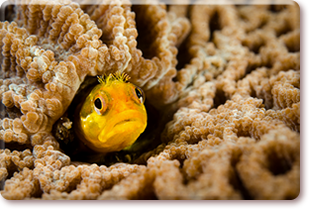 The Department organised a variety of marine conservation education activities targeting various sectors of the community. During the year, 102 public eco-tours, 15 public seminars, 5 beach clean-up activities, 83 school lectures, 51 exhibitions and 19 other kinds of educational activities were held, benefiting over 69,153 participants.
The Department organised a variety of marine conservation education activities targeting various sectors of the community. During the year, 102 public eco-tours, 15 public seminars, 5 beach clean-up activities, 83 school lectures, 51 exhibitions and 19 other kinds of educational activities were held, benefiting over 69,153 participants.
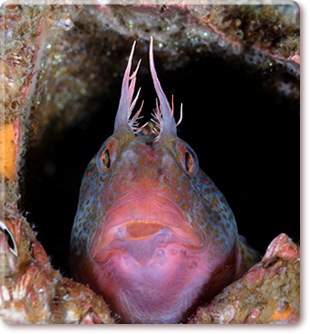 In 2010, the Department launched a pilot scheme of fisheries eco-tourism in Sai Kung and the northeastern waters of Hong Kong in collaboration with local fishermen associations and eco-tourism organsations with an aim to introduce the culture and practices of fisherman communities as well as the ecological and geological features of Hong Kong to the public through marine-based guided tours. It is hoped that the fishermen can gain the experience and skills needed to run the business in a commercially sustainable manner in the future. In addition to Sai Kung and the northeastern waters of Hong Kong, the pilot scheme was extended to Tuen Mun and Tai O waters in August 2012 and January 2013 respectively, allowing more fishermen to participate in the scheme, better equipping them to switch to sustainable eco-tourism activities. During the year, a total of 70 school tours were held with over 1,900 students and teachers participated. Some 290 fishermen have been trained in this scheme. The operation of commercial tours also commenced and a total of 18 commercial tours with 450 participants were conducted.
In 2010, the Department launched a pilot scheme of fisheries eco-tourism in Sai Kung and the northeastern waters of Hong Kong in collaboration with local fishermen associations and eco-tourism organsations with an aim to introduce the culture and practices of fisherman communities as well as the ecological and geological features of Hong Kong to the public through marine-based guided tours. It is hoped that the fishermen can gain the experience and skills needed to run the business in a commercially sustainable manner in the future. In addition to Sai Kung and the northeastern waters of Hong Kong, the pilot scheme was extended to Tuen Mun and Tai O waters in August 2012 and January 2013 respectively, allowing more fishermen to participate in the scheme, better equipping them to switch to sustainable eco-tourism activities. During the year, a total of 70 school tours were held with over 1,900 students and teachers participated. Some 290 fishermen have been trained in this scheme. The operation of commercial tours also commenced and a total of 18 commercial tours with 450 participants were conducted.
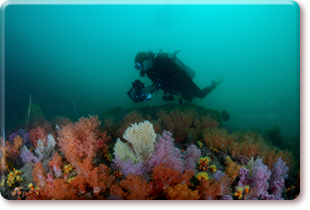 To promote the beauty of marine life and habitats as well as enhance public awareness of the importance in conservation of our marine environment, the Department and the Hong Kong Underwater Association co-organised the “Hong Kong Underwater Photo and Video Competition 2012” from May to October 2012. The competition was well-received with a total of 270 entries submitted. The winning entries were exhibited for the public in the roving exhibitions at Olympic House, Hong Kong Wetland Park, Hong Kong Convention and Exhibition Centre and Hong Kong Cultural Centre between October 2012 and January 2013.
To promote the beauty of marine life and habitats as well as enhance public awareness of the importance in conservation of our marine environment, the Department and the Hong Kong Underwater Association co-organised the “Hong Kong Underwater Photo and Video Competition 2012” from May to October 2012. The competition was well-received with a total of 270 entries submitted. The winning entries were exhibited for the public in the roving exhibitions at Olympic House, Hong Kong Wetland Park, Hong Kong Convention and Exhibition Centre and Hong Kong Cultural Centre between October 2012 and January 2013.
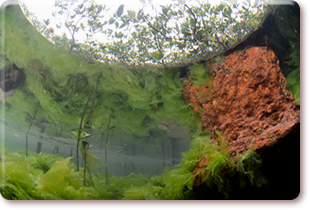 The Department organised 32 dolphin field trips for secondary school teachers and students in collaboration with the Ocean Park Conservation Foundation Hong Kong, in 2012-13. The field trips provided opportunities for students to watch Chinese white dolphins and to learn more about marine conservation.
The Department organised 32 dolphin field trips for secondary school teachers and students in collaboration with the Ocean Park Conservation Foundation Hong Kong, in 2012-13. The field trips provided opportunities for students to watch Chinese white dolphins and to learn more about marine conservation.
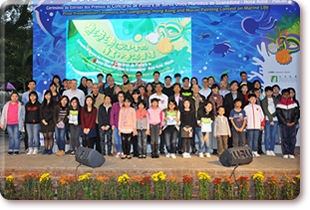 In collaboration with Ocean Park Conservation Foundation Hong Kong, Guangdong Oceanic and Fisheries Administration and Macao Civic and Municipal Affairs Bureau, the Department organised the Guangdong-Hong Kong-Macao Marine Life Drawing Competition 2012. The response was overwhelming and over 11,400 drawings were received.
In collaboration with Ocean Park Conservation Foundation Hong Kong, Guangdong Oceanic and Fisheries Administration and Macao Civic and Municipal Affairs Bureau, the Department organised the Guangdong-Hong Kong-Macao Marine Life Drawing Competition 2012. The response was overwhelming and over 11,400 drawings were received.
LAW ENFORCEMENT
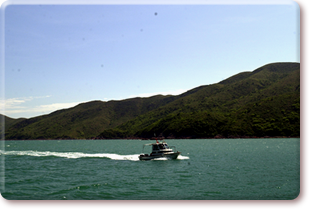 Park wardens patrol country parks and special areas on a regular basis to provide visitor services and to enforce the Country Parks Ordinance and related legislation. In 2012-13, 1,072 offenders were prosecuted or given a fixed penalty notice. Among these, a total of 239 offenders were given a fixed penalty notice for littering or spitting. Statistics are at Appendix 14. Park wardens and nature wardens also conducted frequent special operations in the country parks, such as searching for illegal animal traps, visiting villages for the promotion of fire prevention, enforcing prohibition of feeding wild animals and assisting the Police in search-and-rescue exercises. Regular joint operations with the Police were undertaken to combat crimes, such as illegal felling of Buddhist Pines and Incense Trees.
Park wardens patrol country parks and special areas on a regular basis to provide visitor services and to enforce the Country Parks Ordinance and related legislation. In 2012-13, 1,072 offenders were prosecuted or given a fixed penalty notice. Among these, a total of 239 offenders were given a fixed penalty notice for littering or spitting. Statistics are at Appendix 14. Park wardens and nature wardens also conducted frequent special operations in the country parks, such as searching for illegal animal traps, visiting villages for the promotion of fire prevention, enforcing prohibition of feeding wild animals and assisting the Police in search-and-rescue exercises. Regular joint operations with the Police were undertaken to combat crimes, such as illegal felling of Buddhist Pines and Incense Trees.
In our marine parks and reserve, wardens patrol on a daily basis, watching out for any illegal fishing activities. Close liaison is also maintained with the Marine Police and the Fisheries Authority of Shenzhen to combat illegal fishing by Mainland fishermen in marine parks. Wardens give advice or warnings to visitors and institute prosecutions when necessary. In 2012-13, 44 prosecutions were instituted against illegal fishing activities in marine parks.
MARINE CONSERVATION
Reef Check
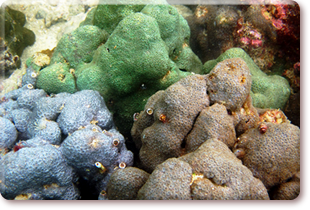 During the year, the Department coordinated the annual Reef Check in collaboration with the Reef Check Foundation. Thirty-three coral sites were surveyed with the assistance of over 570 volunteer divers. Nineteen of these coral sites recorded high coral cover (i.e. more than 50%) and the growth of corals at all sites was stable. Results of the Reef Check were publicised to enhance public awareness of the
During the year, the Department coordinated the annual Reef Check in collaboration with the Reef Check Foundation. Thirty-three coral sites were surveyed with the assistance of over 570 volunteer divers. Nineteen of these coral sites recorded high coral cover (i.e. more than 50%) and the growth of corals at all sites was stable. Results of the Reef Check were publicised to enhance public awareness of the 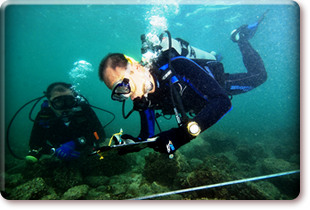 current status of our marine environment and to seek the public's cooperation in protecting our valuable marine resources. The findings also provided the Department with important information on the health status of corals so that appropriate action could be taken to protect them. In 2012, the Department launched the Android version of mobile application "Hong Kong Reef Check". Users can browse the coral coverage of the 33 selected sites, the distribution and pictures of indicator species including reef-building corals, fish and other invertebrates.
current status of our marine environment and to seek the public's cooperation in protecting our valuable marine resources. The findings also provided the Department with important information on the health status of corals so that appropriate action could be taken to protect them. In 2012, the Department launched the Android version of mobile application "Hong Kong Reef Check". Users can browse the coral coverage of the 33 selected sites, the distribution and pictures of indicator species including reef-building corals, fish and other invertebrates.
Conservation of Corals
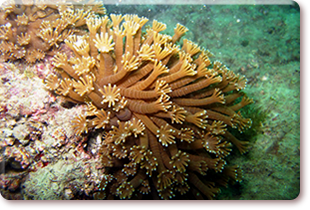 Specially-designed marker buoys were installed at Ung Kong Wan, Sharp Island and Port Island for better protection of corals from anchoring damage. Regular sea patrols and underwater ecological surveys were also conducted to monitor the effectiveness of the coral marker buoys in these areas. The results to date are encouraging. There has been an overall increase in live coral cover in the marker buoy area. Damaged corals have shown signs of recovery.
Specially-designed marker buoys were installed at Ung Kong Wan, Sharp Island and Port Island for better protection of corals from anchoring damage. Regular sea patrols and underwater ecological surveys were also conducted to monitor the effectiveness of the coral marker buoys in these areas. The results to date are encouraging. There has been an overall increase in live coral cover in the marker buoy area. Damaged corals have shown signs of recovery.
Conservation of Marine Mammals
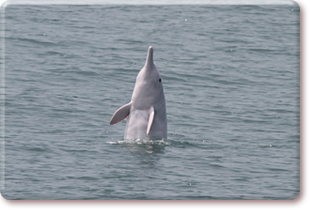 There are some 2,500 dolphins living in the Pearl River Estuary including about 1,300-1,500 dolphins living in the eastern part of the Pearl River Estuary and Hong Kong waters. A study commissioned by AFCD on long-term monitoring of marine mammals in Hong Kong, as one of the conservation measures implemented under the conservation programme for the Chinese white dolphin, detected significant declining trends in numbers of Chinese white dolphins in Hong Kong waters in recent years. Based on detailed analysis, dolphin abundance in three of the main survey areas including West Lantau, Northwest Lantau and Northeast Lantau, showed significant downward trends. The total number in the 3 survey areas dropped from the highest of 158 dolphins in 2003 to the lowest of 61 dolphins in 2012. Conservation actions including habitat protection and management, long-term monitoring of the dolphin population, investigation of dolphin stranding, promotion of public awareness of dolphin conservation, and liaison with the Guangdong authorities to exchange information on the conservation of the species are being pursued. Variations and trends in abundance of dolphins in Hong Kong waters during recent years are closely monitored. AFCD will look into possible causes of the decline in dolphin population and formulate follow-up measures.
There are some 2,500 dolphins living in the Pearl River Estuary including about 1,300-1,500 dolphins living in the eastern part of the Pearl River Estuary and Hong Kong waters. A study commissioned by AFCD on long-term monitoring of marine mammals in Hong Kong, as one of the conservation measures implemented under the conservation programme for the Chinese white dolphin, detected significant declining trends in numbers of Chinese white dolphins in Hong Kong waters in recent years. Based on detailed analysis, dolphin abundance in three of the main survey areas including West Lantau, Northwest Lantau and Northeast Lantau, showed significant downward trends. The total number in the 3 survey areas dropped from the highest of 158 dolphins in 2003 to the lowest of 61 dolphins in 2012. Conservation actions including habitat protection and management, long-term monitoring of the dolphin population, investigation of dolphin stranding, promotion of public awareness of dolphin conservation, and liaison with the Guangdong authorities to exchange information on the conservation of the species are being pursued. Variations and trends in abundance of dolphins in Hong Kong waters during recent years are closely monitored. AFCD will look into possible causes of the decline in dolphin population and formulate follow-up measures.
Every reported dolphin stranding in Hong Kong was investigated by the Department in collaboration with the Ocean Park Conservation Foundation. Tissue samples from the carcasses were collected for further studies. The Department continued to hold exhibitions and seminars as well as to distribute posters and leaflets to promote conservation of marine mammals, and publicise the code of conduct on dolphin watching and the dolphin stranding hotline. Through these efforts, the public gradually deepened their understanding of marine mammals.
Underwater Ecological Surveys
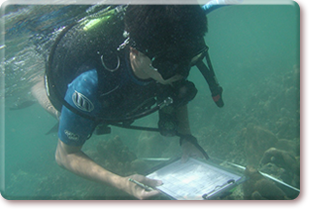 In 2011, the Department formed a diving team for underwater ecological survey comprising staff members who were experienced in scuba diving and underwater ecological survey. During the year, the diving team continued to undertake thematic projects such as the long-term monitoring programmes for hard and soft coral, gorgonian, black coral, reef fish and artificial reefs, and focused studies on coral ecology and algae diversity.
In 2011, the Department formed a diving team for underwater ecological survey comprising staff members who were experienced in scuba diving and underwater ecological survey. During the year, the diving team continued to undertake thematic projects such as the long-term monitoring programmes for hard and soft coral, gorgonian, black coral, reef fish and artificial reefs, and focused studies on coral ecology and algae diversity.
ENVIRONMENTAL IMPACT ASSESSMENT STUDIES
The Department regularly provides comments and advice on development proposals and projects as well as Environmental Impact Assessment studies to ensure that potential impacts of development projects on the marine environment and ecology would be adequately addressed, evaluated and minimised through effective mitigation.